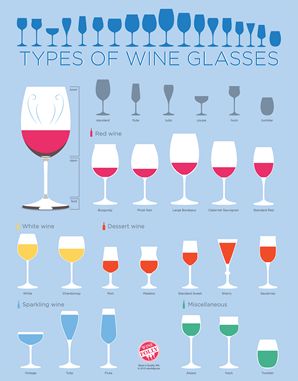
By Larry Mogelonsky, MBA, P. Eng. (www.lma.ca)
“You have chosen…wisely,” is what the immortal knight says to Indiana Jones after he drinks from the Holy Grail – an unsuspecting wooden cup hidden among a swath of poisonous chalices and jeweled goblets.
I’m reminded of this scene at the climax of The Last Crusade whenever I have to make a decision as to how best to pair a chosen wine with its appropriately suitable glassware. Not that it is a blatant faux pas to mismatch wine and glass (at least not in my circle of friends), but proper etiquette should be followed wherever possible. Not only do shape and size affect aroma and flavor via a series of complex molecular interactions, but they offer a strong visual demarcation to augment the overall drinking experience.

Using this diagram from Wine Folly as a companion guide, it’s readily apparent that there are quite a few more types of glasses than you might have stocked at your restaurant. You might only carry white and red glasses (and flutes for champagne), in which case it would serve you well to source perhaps one or two more types so that differential wine orders are given a palpably different treatment.
Think of it as the wine’s garnish. Imagine a couple dining out, one orders a zinfandel while the other gets a cabernet sauvignon. If you present both in the same glassware, there will be little insofar as visible demarcation as both varietals’ purple-red colorations are practically indistinguishable to the layperson. Now pour the zinfandel in standard red and the cabernet sauvignon in a large Bordeaux wine glass – a drastically augmented and more complex drinking experience for both patrons. These effects would be even more pronounced for, say, a guest with a gewürztraminer in an Alsace glass sitting opposite someone with white wine in a wide Chardonnay glass.
As you might also tell from the above diagram, it’s easy to go overboard to the point where you are confusing your servers. Expand as you see fit; the main takeaway here is that when it comes to wine, beer, cocktails, coffee, tea or even milkshakes, we drink with our eyes as much as we do our mouths. Presentation matters; it influences perceived value as well as what you can charge.
Lastly, there has been a recent change towards the more casual ‘tumbler’ style of glasses. These are appropriate as a bistro-style affair and you might wish to consider them for after hours or on a more informal setting. But they should not be utilized for fine dining or with expensive wine.
This article may not be reproduced without the expressed permission of the author.
Editor’s note: To discuss business challenges or to discuss speaking engagements please contact Larry directly.

